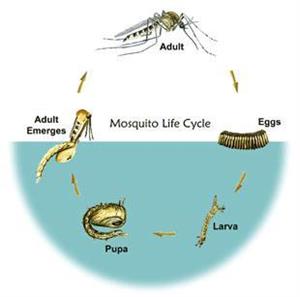Eggs
Eggs are laid one at a time or attached together to form "rafts." They float on the surface of the water. In the case of Culex and Culiseta species, the eggs are stuck together in rafts of up to 200. Anopheles and Aedes, as well as many other genera, do not make egg rafts, but lay their eggs singly. Culex, Culiseta, and Anopheles lay their eggs on the water surface while many Aedes lay their eggs on damp soil that will be flooded by water. Most eggs hatch into larvae within 48 hours; others might withstand subzero winters before hatching. Water is a necessary part of their habitat.
Larva
The larva (plural - larvae) lives in the water and comes to the surface to breathe. Larvae shed (molt) their skins four times, growing larger after each molt. Most larvae have siphon tubes for breathing and hang upside down from the water surface. Anopheles larvae do not have a siphon and lie parallel to the water surface to get a supply of oxygen through a breathing opening. Coquillettidia and Mansonia larvae attach to plants to obtain their air supply. The larvae feed on microorganisms and organic matter in the water. During the fourth molt the larva changes into a pupa.

Pupa
The pupal stage is a resting, non-feeding stage of development, but pupae are mobile, responding to light changes and moving (tumble) with a flip of their tails towards the bottom or protective areas. This is the time the mosquito changes into an adult. This process is similar to the metamorphosis seen in butterflies when the butterfly develops - while in the cocoon stage - from a caterpillar into an adult butterfly. In Culex species in the southern United States this takes about two days in the summer. When development is complete, the pupal skin splits and the adult mosquito (imago) emerges.
Adult
The newly emerged adult rests on the surface of the water for a short time to allow itself to dry and all its body parts to harden. The wings have to spread out and dry properly before it can fly. Blood feeding and mating does not occur for a couple of days after the adults emerge.
How long each stage lasts depends on both temperature and species characteristics. For instance, Culex tarsalis, a common California (USA) mosquito, might go through its life cycle in 14 days at 70° F and take only 10 days at 80° F. On the other hand, some species have naturally adapted to go through their entire life cycle in as little as four days or as long as one month.
*Permission granted for use of illustration and modified text from American Mosquito Control Association®, 15000 Commerce Parkway, Suite C, Mount Laurel, NJ 08054, 856-439-9222 | amca@mosquito.org, Copyright © 2011 All rights reserved, https://www.mosquito.org/
